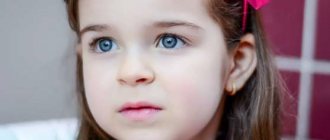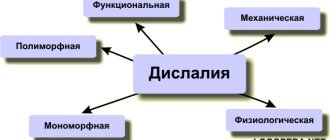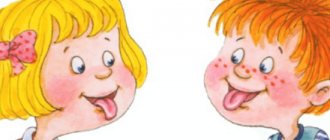A person’s calling card is his speech. Without a doubt, all parents want to see their child healthy, happy and successful. An important role in this is played by the child’s ability to speak correctly and beautifully.
Unfortunately, recently such a phenomenon as speech disorder has become very common. As statistics show, every third child of preschool age has some kind of speech defect. Of course, caring parents try their best to help their child. But how to do that? To do this, you must, at a minimum, have information. To this end, the article provides useful informative material.
The concept of abnormal manifestations of speech
General underdevelopment of speech (GSD) - it means a speech disorder when normally hearing children with preserved mental abilities have unacceptable and completely defective speech: from its sound to its meaning.
This concept was caused by a vital necessity and became firmly established in educational structures for children, in which speech therapy groups were formed. The term OHP was coined by the founder of Russian speech therapy, R. E. Levina (the levels of OHP according to Levina are given below).
Regardless of the origin of the defect, there are systemic complications of speech. Signs of a speech disorder:
- Speaking begins at approximately 3-5 years of age.
- Incorrect wording of words and phrases.
- Pronounced sounds are distorted.
- Incomprehensible conversation.
To distinguish between speech impairment, a speech therapist must conduct a thorough study of the disease of a particular child!
Level 1 grammatical and phonetic features
For conversation, children at this level use onomatopoeia supported by facial expressions and gestures, babbling and unclear sentences built on its basis, with unclear, distorted pronunciation. Also difficult to perceive:
- category of elementary prepositions (with, under, before...);
- grammatical differences between plural and singular;
- generic differences (ran - ran - ran);
- verb tense (does, will do, did);
- degrees of comparison of adjectives (strong - strongest).
The first level is far from perceiving the syllabic structure of a word. Children of the 1st speech level are characterized by a small volume of words of everyday content, pronounced in a babbling manner, truncated. For example: “amot” is a hippopotamus, “iska” is a hare. You can often hear non-existent words in children at an initial speech level - designations of some objects, feelings, actions. For example: “abuki” - boots. Such words can even refer to several objects. For example: “kesya” - candy, sugar, honey, favorite bear, fun. Here the word “kesya” denotes both the object “candy” and that which has a connection with it through associations of qualities: sweet, tasty, bringing joy, a state of pleasure.
Children at this level do not use morphological phenomena to build grammar. This means that the “phrase” consists of root words without the use of prefixes, suffixes and endings, depending on the situation. Such “phrases” can only be understood in the context of a specific situation; the child tries to describe it with a lack of vocabulary using gestures, facial expressions, exclamations, and onomatopoeia.
Classification of speech disorders (table)
The clinical-pedagogical and psychological-pedagogical classification makes an in-depth analysis of complications in the speech sphere, showing the problem from different sides. Thus, she paints a complete picture of this illness, which allows you to choose the best way to help.
| Clinical and pedagogical | Psychological and pedagogical |
| Speech background failure (external design) | Means of communication are disrupted |
|
|
| Defects in the construction of linguistic means and their significance | Communication difficulties |
|
|
R. E. Levina and her colleagues developed a unified pedagogical approach that made it possible to see the process of abnormal child development, taking into account certain indicators. The teacher systematized systemic speech disorders and substantiated a new method of organizing a system of corrective work to overcome them in preschoolers.
General speech underdevelopment in children
Typically, the causes of the development of this pathology are various provoking factors that can affect the child’s body at different periods of his life.
These factors include:
- hereditary predisposition - the likelihood of developing OHP increases if parents have hormonal disorders, mental illness, mental retardation, severe metabolic disorders;
- problems during pregnancy - Rh conflict of the mother and fetus, viral diseases of the mother, threats of miscarriage, falling on the stomach, bad habits (alcohol abuse, smoking), severe stress, taking certain medications during pregnancy;
- complications during childbirth (protracted or too fast labor, cesarean section, fetal asphyxia, mechanical injuries received by the baby while passing through the respiratory tract, and so on);
- some diseases suffered by the child in the first years of life (meningitis, pneumonia, dysentery, chronic otitis media, bruises and concussions, intoxication of the body as a result of poisoning and a number of others);
- the influence of social factors (early start of learning a second language, improper upbringing, severe long-term stress, mental trauma, poor living conditions, and so on).
In its pure form, OHP is rarely observed. Usually the disease is accompanied by neuropsychic disorders, as well as somatic problems.
Inadequate speech or its complete absence has a negative impact on the overall development of the child, the formation of his communication skills and intelligence.
OHP is not uncommon; pathology is recorded in approximately 40% of children aged 3 to 7 years. In this case, speech underdevelopment is divided into 4 degrees of severity, which are discussed below.
OHP in most cases is treatable, the goal of which is:
- elimination of incorrect pronunciation of sounds;
- development of correct perception of words by sounds;
- vocabulary enrichment;
- correct construction of long sentences;
- the ability to parse words by sounds.
| Speech correction methods | The essence of the method | Examples |
| Speech therapy exercises | The method is aimed at developing memory and thinking, the ability to control the muscles of the face and tongue, as well as correct breathing when pronouncing sounds. |
|
| Speech therapy massage | The massage is aimed at strengthening the muscles of the speech apparatus, forming a correct bite, and also restores blood supply to the tissues that are responsible for the development of speech. It is important that massage has contraindications. | To perform a massage, a specialist can use a special brush, vibrating massager or probe massage. It is recommended that procedures be carried out only by a specialist with experience and certificates. |
| Medication method | A specialist prescribes medications to improve blood circulation in the brain. When choosing drugs, it is important to consider the patient’s contraindications. |
|
| Visit to a psychologist | The doctor talks with the child and teaches him not to be ashamed of the defect and not to withdraw into himself. It also reveals whether OHP is a consequence of a psychological disorder. For effectiveness, a psychologist may prescribe sedatives for children. |
|
For quick and successful results, it is recommended to use these methods in a comprehensive manner.
Definition of speech anomaly
ONR often occurs in the following syndromes: dysarthria, rhinolalia, alalia, aphasia. Based on this, 3 groups are distinguished:
- Uncomplicated forms of OCD (slight impairment of brain function is observed).
- Complicated forms of OPD (those with mental personality disorders or pathological changes in the development of the central nervous system).
- Severe speech pathology (when the functioning of the parts of the brain responsible for speech is disrupted).
When it becomes clear what form of anomaly the baby has, the level of speech skills is determined.
ONR forms
The following forms of speech underdevelopment are distinguished:
- OHP level 1. The child completely lacks coherent speech. In the medical field, the characteristic of OHP at this level sounds like “speechless children.” The child tries to convey his thoughts to others using gestures or extremely unclear, simplified speech.
- OHP level 2. The patient has developed basic speech, but the vocabulary of children with OHP is extremely poor. The child pronounces most words incorrectly, making mistakes. The maximum that a patient with this stage of the disease can do is compose and pronounce the simplest possible sentence of a few words.
- General speech underdevelopment level 3. The patient is quite good at composing sentences, but pronounces words with errors, and the meaning of the sentences may not be clear to others.
- OHP level 4. The patient speaks well and can form sentences. The speech of a child with ODD at this stage is practically no different from his peers. Problems arise only when composing long phrases.
| ONR forms |
In addition, medicine has adopted a classification according to which the following types of disease are distinguished:
- uncomplicated OCD - observed with minor impairment of brain activity;
- complicated OCD - diagnosed against the background of one or another psychiatric or neurological disorder;
- general underdevelopment of speech in children associated with pathologies of the speech centers of the brain.
Determining the level of speech development of a child
Typically, all patients with general speech underdevelopment always have a malfunction in the articulatory and auditory systems. Also, their lexical arsenal contains a small number of words.
OHP levels and their characteristics
First level. There are practically no words. The passive vocabulary is very small. There is no understanding of the meaning of most words. In everyday life there are either babbling words or syllables of an onomatopoeic nature, one-word sentences used situationally (gestures and facial expressions are used). More often, only sound combinations consisting of 1-2 syllables are inherited. A gross violation of the perception of the system of meaningful sounds and the syllabic structure of words. The articulatory system malfunctions, sounds constantly change places, and, unfortunately, children are not able to pronounce many of them.
Second level. First attempts at coherent speech. Although babbling and gestures are still present, words appear, albeit distorted, but already constant, which are in general use. The vocabulary is still poor. Syllables are rearranged. Simple sentences appear with 2-3 words. The sounds are defective, often mixed and replace each other.
Third level. Children actively use expanded speech, but mostly use simple constructions. The volume of the dictionary is noticeably expanding: almost all parts of speech are used. Sound pronunciation and phonemic processes still do not fit into the norm, but there are fewer violations.
The fourth level (according to Filicheva). Characterized by minor deficiencies in phonetics, vocabulary and grammar. All these violations are not clearly expressed: the structure of syllables of words (complex), the joint work of the speech organs and the process of receiving and transforming sound information, changing and forming words are disrupted. This level of speech underdevelopment can only be detected through a thorough examination of the child by a speech therapist.
It is very important to detect possible disorders in your baby in time in order to prevent or eliminate them!
Diagnostics
The diagnosis of onr can only be made by conducting a comprehensive study. Diagnosis is carried out at an initial consultation with a speech therapist. The specialist establishes contact with the child, the parents must have medical reports from a neurologist, pediatrician, and the results of the studies. Having received all available information, the specialist studies and determines the speech status of his patient.
Speech therapy research is carried out in two stages - orientation and language examination. The orientation is carried out through a conversation with parents. This way, all the features of the course of the disease are clarified, what reasons accompanied it, and how the speech apparatus developed. The patient himself is also assessed - his ability to make contact, articulatory motor skills.
When examining the language and its components, the formation of speech, its coherence, grammar, and vocabulary are determined. In the case of the presence of OHP of the first degree, there is a gross underdevelopment of all components of the language system, which is explained by the child’s lack of commonly used speech. After this, the specialist can draw up his conclusion and establish the clinical form of the pathology of the speech apparatus.
Recommended speech therapy examination
It is worth studying in detail the vocabulary of a person suffering from OPD. This will allow you to assess the ability to correlate a word with a specific subject. This is done in several steps:
- Selection of material, divided into individual lexical topics. This determines the child’s ability to communicate with the people around him.
- Pictures with objects are offered.
- Pictures with names of body parts are used.
- Selection of synonyms for the selected word.
During the diagnosis, the speech therapist must give his conclusion, which indicates the level of speech development, the clinical picture, the degree of OHP, and also draw up a plan for correcting the identified disorders.
Useful and interesting facts
Ancient people spoke quite primitively, including vocal, visual and tactile functions. It was more like an exchange of information among animals. We learned to talk, when we started using symbols, we began to want to share this knowledge with our people. Scientists believe that the first symbol appeared when they began to make tools from stone. This was almost 2.5 million years ago. The activity played a leading role in the history of the development of human communication.
The first mention of speech defects associated with physical injury was in the ancient Egyptian papyrus of Edwin Smith. In religious epics, such as the Bible and the Koran, there are descriptions of miraculous healing of speech disorders. The priests gave a divine coloring to the fact of difficult speech.
Hippocrates was the first to write about the role of the brain in his writings, where he outlined his view of how the formation of human voice and speech occurs.
The speech correction process is quite lengthy and labor-intensive. The accumulated experience of specialized specialists shows that it is parents who need to pay special attention to the environment in which the baby lives. You also need to engage in speech development from a very early age.
Grammar, phonetics, vocabulary level 4
The judgments of a child at level 4 of speech development are logical and formed into complex sentences. The grammatical structures are harmonious, but sometimes have distortions. The child uses all parts of speech, is not fully aware of their purpose, masters declination, changes in numbers, gender, tenses quite well in speech practice, and begins to use degrees of comparison.
The sound system may still be imperfect, especially when changing baby teeth. Speech is already quite harmonious, but unclear pronunciation of sounds may be observed, which is why the effect of blurred words is recognized.
Syllable division is already perceived visually, which signals the child’s readiness to begin mastering the phonetic basics of the language.
The child learns many new words and often tries to guess their meaning from the context. As a result, the semantic content of the word is not fully mastered, which will later become noticeable when constructing your own statements using these words. For example: “The plane took off high into the sky and flew to the moon!” The child has only learned that the plane flies, but does not know the full characteristics of its properties.
Grammar, phonetics, word creation, semantic content at the 3rd level
The child’s vocabulary at the 3rd level of speech development is replenished; it already includes words naming the qualities of objects, actions and phenomena. At this stage, all parts of speech can be traced in children’s speech, but sometimes their functions are not meaningful. The child expresses himself in sentences, sometimes even complex ones, if the category of function of conjunctions and allied words is mastered. If not, then when you try to express yourself in a complex sentence with a cause-and-effect relationship, you get a similar construction: “I didn’t draw, ... I lost my pencil.”
Difficulties at this stage can still be caused by grammatical changes in word form and word formation. But the tense category of the verb, the case change of nouns, adjectives and numerals are already realized. The category of gender has been mastered, but difficulties may arise if you do not know which gender a particular word belongs to. For example: “Today I saw such a beautiful snowstorm, it circled and circled!” This shows ignorance of the gender of the word “blizzard”. Errors in accent persist. For example: “poured water.”
During this period, difficulties may still arise with the pronunciation of individual sounds (hissing, sonorant, whistling). Syllable division is recognized by ear by many children, but only as an intuitive rhythmic division of a word.
The child may already be able to compose stories based on pictures with a brief description of the qualities, shape, size, and color of objects.
Work on speech development at level 3
A child at this stage can usually listen well to short stories from children's literature, fairy tales, and poems. Also, 4-5 year olds already like to retell what someone has read out loud. Reading will help enrich your vocabulary and master the algorithm for grammatically correct construction of phrases and sentences. Retelling, especially from pictures, is already an attempt to apply grammatical, word-formation and lexical norms in practice.
Coming up with poems based on two or four rhymes, role-playing conversations on behalf of toys or fictional characters - all this will help the child understand the ways of constructing speech depending on the situation. To work out the classification of words according to one or more criteria, working with cards with images of animals, products, furniture, things, and seasons will help.
To better master the morphological side of language, a child needs to pay his attention to endings associated with gender, case, and tense. Make it clear that there are parts of a word that serve to form many words.
At level 3, you can already introduce simple phrases. The time for tongue twisters will come at level 4.






